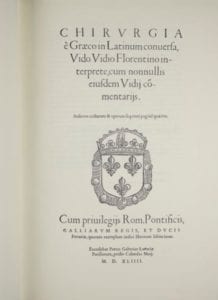
The sixteenth century Florentine anatomist and surgeon Guido Guidi is usually referred to by his Latinized name Vidus Vidius.1-4 He was born in 1509 from a fortunate union of medicine and art by having a physician as his father and the grand-daughter of the famous Florentine painter Domenico Ghirlandaio as his mother. Her name was Costanza, and she had brought Dr. Giuliano Guidi a dowry of 700 florins.1
Nothing is known of the life of Vidius as a young man, neither of his studies, nor indeed from where (or indeed whether) he obtained a medical degree.1-4 His is not mentioned in the medical records or official documents of Florence, and we know nothing of his life or activities during the troubled times of the Florentine republic, the siege of the city in 1529, or the bad times during the reign of Alessandro de Medici.1 The only surviving record is a three page consultation written in 1540 on a patient whom he never saw and who suffered from some form of dysentery with fever. He recommended honey, iron, lemon juice, pomegranates, several other strange ingredients, as well as venesection and various local applications.1
Before 1540 Vidius seems to have spent some time in Rome, writing and practicing or observing medicine. There he must have come to the attention of Francis I, the great patron of the arts and literature, who in 1544 invited him to be his personal physician and teach at the College of France.1-4 On becoming king, Francis had attracted many illustrious persons to France, including Leonardo da Vinci, and in 1530 had founded the Royal College to teach the humanities, principally the three classic languages, Hebrew, Greek, and Latin.1 Vidius was the first professor of anatomy and medicine at the Royal College.1
In Paris, Vidius befriended Benvenuto Cellini, whom he may have known earlier in Rome, and who mentions him in his memoirs.5,6 Cellini suffered from several diseases—malaria, common in Rome at the time; perhaps typhoid fever; some kind of a skin eruption; possibly also syphilis; and was attended at various times by Vidius and also by Berengario da Carpi.5 In Paris, Vidius first began work on his illustrated anatomy book Chirurgia. Still based on the traditional works and opinions of Hippocrates, Galen, and Oribasius, it appeared in 1544 and has been regarded as one of the great books of his time. Illustrated by the famous Mannerist painter Francesco Primaticcio of Bolgna,6 it included many of the instruments used by these ancient physicians, and has descriptions of joints, treatment of fractures and dislocations, a method of performing tracheostomy, and an early reference to varicella. His friendship with Benvenuto Cellini may have influenced the artistic excellence of the work.
In 1547 Vidius returned to Florence. There he became the personal physician of Duke Cosmo de Medici, and taught at the university of Pisa, by then a Florentine possession. He was ennobled, took holy orders, and wrote a book on the art of medicine that was left unfinished at his death and completed by his nephew between 1596 and 1611. Beyond his description of the eponymously named Vidian artery and nerve in the skull, he remains in the eyes of modern critics the pioneer whose beautiful book blended aesthetics with the pursuit of knowledge, occupying an equal place in the history of art, literature, and science.1
References
- Grmek MD. Contributions a la biographie de Vidius (Guido Guidi) premier lecteur royal de medine, ses origins et sa vie avant la periode parisienne. Revue d’histoire des sciences 1978; 31:289 (4 Oct)
- Tubs RS and Salter EG. Vidius Vidius (Guido Guidi). Neurosurgery 2006; 59:1509 (Jul)
- Bahsi,I. Life of Guido Guidi (V idus Vidius), who named the Vidian canal. Child’s Nervous System,2018
- Brockbank W. The man who was Vidius (1508-1569) Annals of the Royal of College of Surgeons of England 1969; 19:269
- Benvenuto Cellini. British Medical Journal 1939; 2:1058 (20 Dec)
- Freeman JF. Physicians and humanities in the world of Francis I. Journal of the History of Medicine and Allied Sciences 1975; 30:124 (April).

Leave a Reply